Preventive health care expenditure statistics
Data extracted in March 2024.
Planned article update: May 2025.
Highlights
EU Member States spent €95.3 billion on preventive health care in 2021; note that this was the second year of the COVID-19 crisis.
Preventive health care expenditure in the EU was equivalent to 0.65 % of GDP in 2021.
Current expenditure on preventive healthcare relative to GDP, 2021
This article forms part of the online publication Health in the European Union and more specifically is part of the domain of healthcare expenditure statistics. It presents key statistics on preventive healthcare expenditure in the European Union (EU) for the reference year 2021. With the release of 2021 data, the data in this article relate information on preventive healthcare expenditure during the second calendar year of the COVID-19 crisis. Preventive healthcare expenditure in the EU increased 88.2 % in current price terms between 2020 and 2021 and from 0.38 % to 0.65 % as a percentage of GDP. This reflects the impact of the COVID-19 pandemic, in particular for the category 'Immunisation programmes' that includes vaccination campaigns. The aggregated expenditure in the 19 member states which provided separated data on such programmes for 2020 and 2021 soared by 343.2 % and, accordingly, the share of immunisation programmes on the overall 'Preventive care' expenditure increased from 13.7 % in 2020 to 29.1 % in 2021.
Within the health sector, preventive care involves 'any measure that aims to avoid or reduce the number or severity of injuries and diseases, their sequelae and complications' [1]. It is based on a health promotion strategy that enables people to improve their health by controlling some immediate determinants [2]. Preventive healthcare includes interventions for both individual and collective consumption.
According to the 2011 edition of the system of health accounts (SHA 2011), preventive healthcare aims to reduce the 'risks before they generate some effects' [3] and to detect diseases as early as possible. Activities aimed at 'reducing the negative impact of an already established disease or injury by an attempt to avoid worsening and complications and then therapy' are therefore outside the scope of preventive healthcare [4]. For some countries, it can be difficult to identify expenditure on preventive healthcare separately from expenditure on curative and rehabilitative care [5], leading to an underestimation in this area.
Full article
Preventive healthcare in the EU accounted for 0.65 % of GDP in 2021
Relative to GDP, Austria, the Netherlands and Denmark spent the highest amount on preventive healthcare in 2021
Current expenditure on preventive healthcare can be analysed in absolute terms (euros), relative to GDP or per inhabitant (see the average population), as presented later in this article.
Relative to the size of its economy, Austria had the highest expenditure on preventive healthcare in 2021 among the EU Member States, at 1.25 % of its gross domestic product (GDP). The Netherlands (0.96 %) and Denmark (0.95 %) had the next highest ratios, while Finland, Germany and Czechia also reported expenditure on preventive healthcare above 0.75 % of GDP (see Figure 1 and Table 1).
Slovakia (0.12 %), Malta (0.13 %) and Poland (0.14 %) recorded the lowest ratios and were the only EU Member States to allocate less than 0.20 % of their GDP to expenditure on preventive healthcare in 2021.
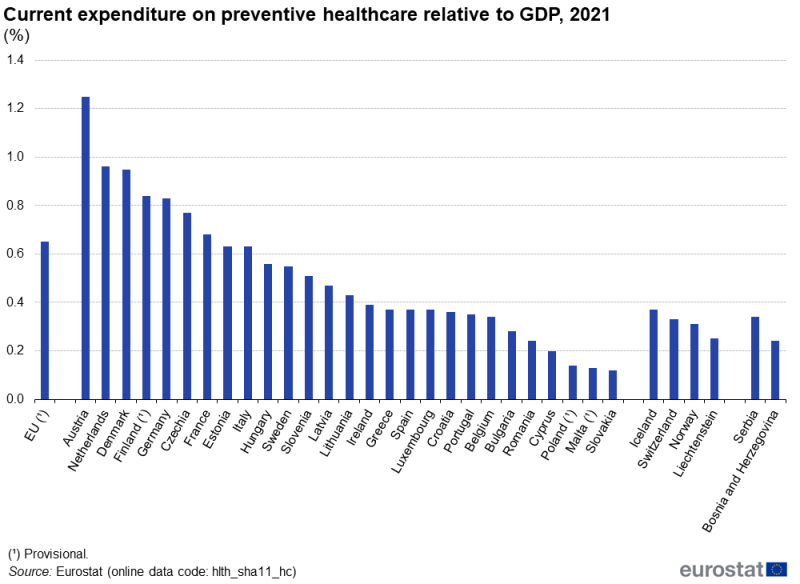
(%)
Source: Eurostat (hlth_sha11_hc)
In absolute terms, total expenditure on preventive healthcare for all EU Member States amounted to €95.3 billion in 2021.
- Germany spent €30.0 billion on preventive healthcare, recording the highest value among the Member States; it was also the only Member State to spend more than €20 billion.
- Two other Member States spent more than €10.0 billion on preventive healthcare in 2021: France (€16.9 billion) and Italy (€11.4 billion).
- At the other end of the ranking, Cyprus (€49.6 million) and Malta (€19.4 million) recorded the lowest values across the EU; they were the only Member States to spend less than €100 million.
These amounts are partly proportional to the size of the population. This characteristic can be appropriately described by an analysis of the costs per inhabitant.
There were 14 EU Member States that spent more than €100 per inhabitant on preventive healthcare in 2021
With expenditure of €566.4 and €555.1 per inhabitant, respectively, Austria and Denmark spent the most relative to their population size
Taking into account the size of the population, Austria (€566.4 per inhabitant) and Denmark (€555.1 per inhabitant) had the highest levels of preventive healthcare expenditure in 2021 among the EU Member States (Table 1). Two other EU Member States recorded expenditure above €400.0 per inhabitant: the Netherlands (€476.9 per inhabitant) and Luxembourg (€421.0 per inhabitant). At the other end of the scale, Malta (€37.4 per inhabitant), Romania (€30.5 per inhabitant), Bulgaria (€28.7 per inhabitant), Slovakia (€23.0 per inhabitant) and Poland (€20.6 per inhabitant) reported the lowest values per inhabitant in 2021. The ratio between the highest and lowest levels of preventive healthcare expenditure per inhabitant – based on a comparison between Austria and Poland – was therefore 27.5 : 1.
Table 1 also shows the level of expenditure on preventive healthcare measured in purchasing power standards (PPS), which that takes account of the price level differences between countries; these data expressed in relation to the number of inhabitants are also shown in Figure 2.
- Among the EU Member States, Germany had the highest value in absolute terms in 2021, with expenditure on preventive healthcare of 27.7 billion PPS.
- Based on the ratio of preventive healthcare expenditure per inhabitant (measured in PPS terms), Austria (481.2 PPS per inhabitant) spent the most on preventive healthcare, followed by the Netherlands, Denmark and Germany, all with values above 300.0 PPS per inhabitant.
- Slovakia was at the other end of the ranking, with expenditure of 28.1 PPS per inhabitant in 2021.
Figure 2, shows that EU Member States with relatively high levels of expenditure on preventive healthcare per inhabitant in euro terms tended to have lower ratios in PPS terms; the reverse was observed for Member States with relatively low levels of expenditure. Unsurprisingly therefore, the ratio between the highest and lowest levels of preventive healthcare expenditure per inhabitant when measured in PPS (taking account of price level differences) – based on a comparison between Austria and Slovakia – was considerably less (17.1 : 1) in 2021 than the ratio in euro terms (27.5 : 1).
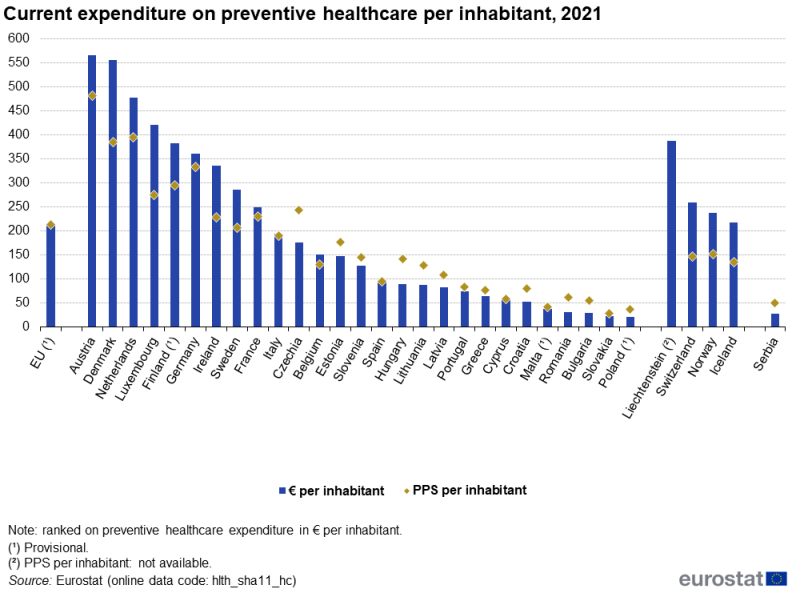
Source: Eurostat (hlth_sha11_hc)
Among EU Member States, spending on preventive healthcare ranged between 1.2 % and 10.3 % of current healthcare expenditure in 2021
Austria spent the highest share of health expenditure on preventive healthcare
At 6.0 % of current healthcare expenditure across the EU, preventive healthcare was a notably greater function within the system of health accounts in 2021 than in 2020 when its share had been 3.5 %.
In 2021, the share of preventive healthcare expenditure in total health expenditure was highest among the EU Member States in Austria, at 10.3 % – see Figure 3. Denmark (8.9 %) and the Netherlands (8.7 %) reported the next highest shares, while shares above 7.0 % were also recorded for Estonia, Finland, Czechia and Hungary. At the other end of the ranking, four Member States reported shares below 3.0 %: Cyprus (2.2 %), Poland (2.1 %), Slovakia (1.6 %) and Malta (1.2 %).
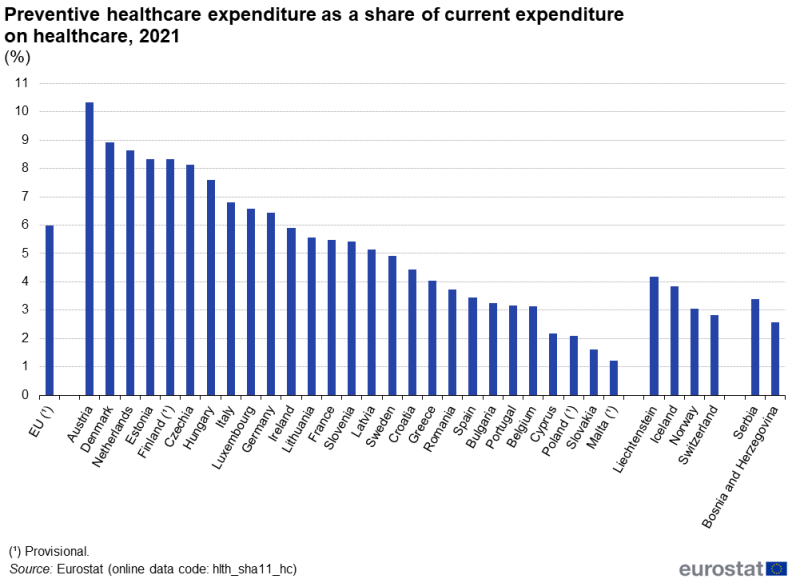
(%)
Source: Eurostat (hlth_sha11_hc)
Preventive healthcare mainly financed by government schemes
In Malta, Denmark, Spain and Latvia, preventive healthcare was almost entirely financed by government schemes in 2021
Healthcare financing schemes are a structural component of healthcare financing systems: they are the types of financing arrangements through which people obtain health services [6].
Figure 4 shows that government schemes were the main mechanism for financing preventive healthcare in 2021 in 24 of the EU Member States. Shares varied among these 24 Member States from 55.3 % in Slovenia to 98.5 % in Latvia, 98.9 % in Spain, 99.5 % in Denmark and 100.0 % in Malta. On average, government schemes financed 63.7 % of preventive healthcare across the EU in 2021.
Compulsory contributory health insurance schemes and compulsory medical saving accounts (CMSA) (which are generally part of the social security system) were the second largest financing mechanism, accounting for a 28.6 % share of the EU's total preventive healthcare expenditure in 2021. They were the main mechanisms for financing preventive healthcare in the three remaining EU Member States: Croatia (81.6 %), Czechia (76.4 %) and France (74.2 %).
In 2021, enterprise financing schemes accounted for 5.9 % of preventive healthcare expenditure in the EU. In seven EU Member States, this share exceeded 10.0 %, with the two highest shares in Portugal (25.2 %) and Poland (27.0 %). With an average share of 1.1 %, household out-of-pocket payments did not play a significant role in the financing of preventive healthcare within the EU in 2021. The relative contribution of this means of financing was highest in Ireland at 5.3 %.
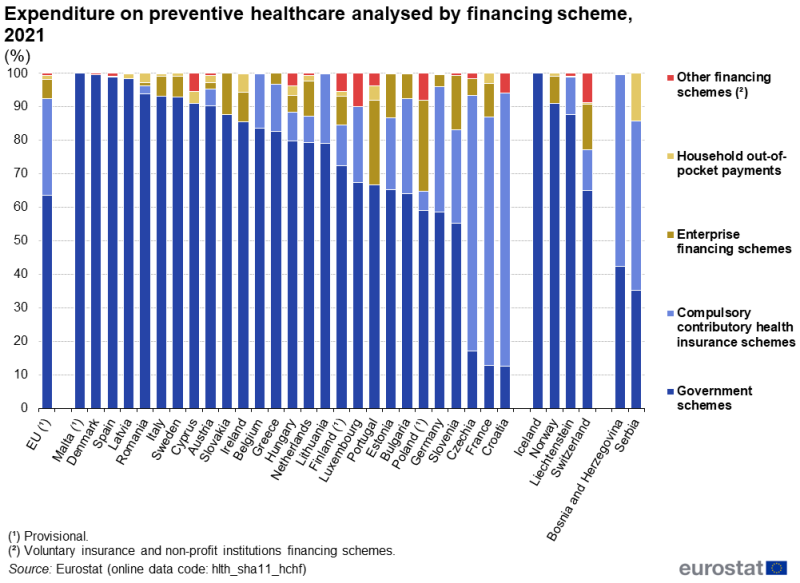
(%)
Source: Eurostat (hlth_sha11_hchf)
Preventive healthcare mainly delivered by providers of preventive health care in 2021
Healthcare providers are 'organisations and actors that deliver healthcare goods and services as their primary activity, as well as those for which healthcare provision is only one among a number of activities. They vary in their legal, accounting, organisational and operating structures' [7].
Providers of preventive care were the main providers of preventive healthcare in 13 EU Member States in 2021
Figure 5 shows there were two main providers of preventive healthcare in the EU.
- Providers of preventive care, which include 'organisations that primarily provide collective preventive programmes and campaigns/public health programmes for specific groups of individuals or the population as a whole, such as health promotion and protection agencies or public health institutes as well as specialised establishments providing primary preventive care as their principal activity' [8]. Across the EU, providers of preventive care accounted for an absolute majority of current expenditure on preventive healthcare (51.6 ).
- Providers of ambulatory healthcare, defined in the system of health accounts as 'establishments that are primarily engaged in providing healthcare services directly to outpatients who do not require inpatient services. This includes both offices of general medical practitioners and medical specialists and establishments specialising in the treatment of day-cases and in the delivery of home care services' [9]. Providers of ambulatory healthcare accounted for more than one quarter of the EU's current expenditure on preventive healthcare (26.8 ).
In 2021, there were 14 EU Member States where providers of preventive care accounted for an absolute majority of current expenditure on preventive healthcare and in two more these providers accounted for less than half of all expenditure but for more than any other type of provider. The most shares of expenditure for providers of preventive care were observed in Slovakia (87.6 %) and Italy (81.0 %).
Providers of ambulatory healthcare accounted for an absolute majority of current expenditure on preventive healthcare in six of the EU Member States and in two more these providers accounted for less than half of the total but for more than any other type of provider. The most shares of expenditure recorded for providers of ambulatory healthcare were observed in Portugal (81.4 %) and Finland (79.5 %).
In three EU Member States, the largest provider of preventive healthcare in 2021 was not one of the two principal types of providers – preventative care or ambulatory healthcare – which dominated across the EU as a whole.
- The rest of the economy accounted for 43.5 % of preventive healthcare expenditure in Bulgaria. This heading encompasses households as providers of home health care and other industries as secondary providers of health care. For comparison, the average share in the EU was 4.3 %.
- Providers of healthcare system administration and financing accounted for 38.0 % of preventive healthcare expenditure in Poland. The average share in the EU was 2.3 %.
- In Greece, hospitals had the highest share of preventive healthcare expenditure, at 34.7 %. The EU average was 2.4 %.
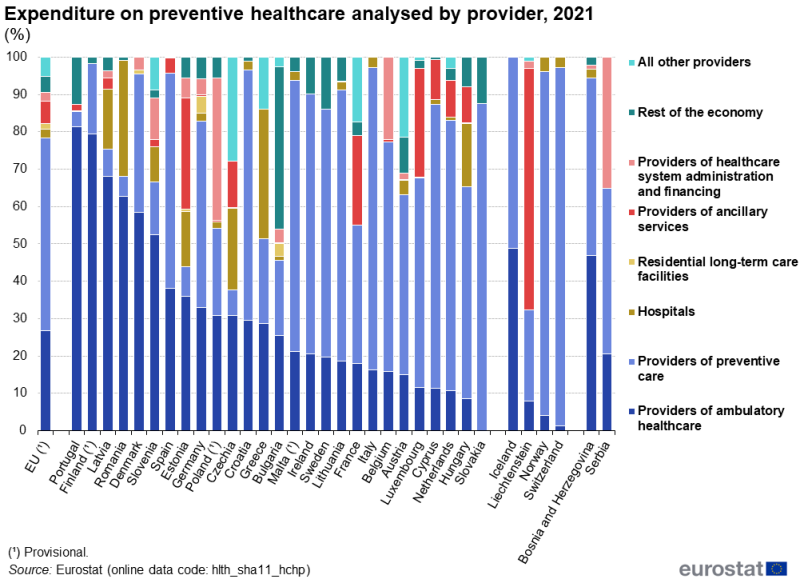
(%)
Source: Eurostat (hlth_sha11_hchp)
Source data for tables and graphs
![]() Preventive healthcare expenditure data: tables and figures
Preventive healthcare expenditure data: tables and figures
Data sources
Tables in this article use the following notation:
- values in italic show where a value is provisional;
- a colon ' : ' is used to show where data are not available.
Key concepts
Current expenditure on health care equals 'final consumption expenditure of resident units on health care goods and services, including the health care goods and services provided directly to individual persons as well as collective health care services' [10].
Healthcare expenditure is primarily concerned with healthcare goods and services that are consumed by resident units, irrespective of where that consumption takes place (it may be in the rest of the world) or who is paying for it. As such, exports of healthcare goods and services (to non-resident units) are excluded, whereas imports of healthcare goods and services for final use are included.
System of health accounts
Eurostat, the Organisation for Economic Co-operation and Development (OECD) and the World Health Organization (WHO) established a common framework for a joint healthcare data collection exercise. The data collected relate to healthcare expenditure following the system of health accounts (SHA) methodology.
The system of health accounts shares the goals of the system of national accounts (SNA) 'to constitute an integrated system of comprehensive, internally consistent and internationally comparable accounts, which should as far as possible be compatible with other aggregated economic and social statistical systems'. Health accounts provide a description of the financial flows related to the consumption of healthcare goods and services from an expenditure perspective. Health accounts are used in two ways:
- internationally, where the emphasis is on a selection of comparable expenditure data;
- nationally, with more detailed analyses of healthcare spending and a greater emphasis on comparisons over time.
In 2011, and as a result of four years of extensive and wide-reaching consultation, Eurostat, the OECD and the WHO released an updated manual for the collection of health accounts, A System of Health Accounts 2011, revised edition. The core set of SHA tables addresses three basic questions.
- What kinds of healthcare goods and services are consumed?
- Which healthcare providers deliver them?
- Which financing schemes are used to deliver them?
Healthcare expenditure is recorded based on the international classification for health accounts (ICHA).
- Healthcare expenditure by financing schemes (ICHA-HF) – which classifies the types of financing arrangements through which people obtain health services; healthcare financing schemes include direct payments by households for services and goods and third-party financing arrangements.
- Healthcare expenditure by function (ICHA-HC) – which details the split in healthcare expenditure following the purpose of healthcare activities, such as, curative care, rehabilitative care, long-term care or preventive care.
- Healthcare expenditure by provider (ICHA-HP) – which classifies units contributing to the provision of healthcare goods and services, such as hospitals, residential facilities, ambulatory healthcare services, ancillary services or retailers of medical goods.
OECD guidelines for reporting preventive care have been published as Expenditure on Prevention Activities under SHA 2011: Supplementary Guidance - March 2017 version.
Healthcare expenditure – methodology
Commission Regulation (EU) 2015/359 of 4 March 2015 as regards statistics on healthcare expenditure and financing established the collection of data on healthcare expenditure according to SHA 2011 methodology. This Regulation applied to data from reference years 2014 until 2020. Commission Regulation (EU) 2021/1901 of 29 October 2021 as regards statistics on healthcare expenditure and financing covers data from the 2021 reference year onwards. These regulations lay down rules for the development and production of European statistics in the area of healthcare expenditure and financing.
The background article Healthcare expenditure statistics – methodology documents healthcare expenditure statistics. It provides more information on the scope of the data, the legal framework, the methodology employed, as well as related concepts and definitions.
Context
Health systems across the globe are developing in response to a multitude of factors, including:
- new medical technology and improvements in knowledge;
- new health services and greater access to them;
- changes in health policies to address specific diseases and demographic developments;
- new organisational structures and more complex financing mechanisms.
However, access to healthcare and greater patient choice is increasingly being considered against a background of financial sustainability.
Europe is home to some of the lowest levels of income/wealth inequality, as well as some of the highest standards for working conditions and broad social protection. At the Gothenburg Summit in 2017, the European Parliament, the Council and the European Commission proclaimed the European Pillar of Social Rights. This set out 20 key principles for guiding the EU towards a strong, social Europe that is fair, inclusive and full of opportunity in the 21st century. Under the action plan for social protection and inclusion, the European Commission acts to promote health and care systems; these were under considerable strain during the COVID-19 pandemic. Reforms and investments in health systems are required to:
- increase their resilience and capacity to manage current and future crises;
- reinforce primary health care and mental health;
- improve access to quality health care for all and reduce social, territorial and economic inequalities in health.
The European Commission aims to build a strong European Health Union in which all EU Member States prepare and respond together to health crises, where medical supplies are available, affordable and innovative, and where countries work together to improve prevention, treatment and aftercare for diseases.
The European Commission has adopted strategic plans for the period 2020–2024 to translate President von der Leyen's six headline ambitions. In order to improve the quality and effectiveness of public expenditure and contribute to prosperity and social cohesion, the European Commission seeks to provide expertise on health systems and support actions that help prevent and reduce the impact of ill-health on individuals and economies, while encouraging and supporting innovation and the uptake of modern technologies for better care delivery and cost-effectiveness [11].
Direct access to
Notes
- ↑ Pomey et al. (2000) in A system of Health Accounts 2011, revised edition page 100.
- ↑ A System of Health Accounts 2011, revised edition page 100.
- ↑ A System of Health Accounts 2011, revised edition page 100.
- ↑ A System of Health Accounts 2011, revised edition page 100.
- ↑ Preventive actions such as check-ups provided during a contact with a general practitioner might be included in expenditure for curative care.
- ↑ A System of Health Accounts 2011, revised edition page 164.
- ↑ A System of Health Accounts 2011, revised edition page 122.
- ↑ A System of Health Accounts 2011, revised edition page 145.
- ↑ A System of Health Accounts 2011, revised edition page 135.
- ↑ A System of Health Accounts 2011, revised edition page 38.
- ↑ Strategic Plan 2020–2024 DG Health and Food Safety (DG SANTE).
Online publication
Methodology
Healthcare expenditure statistics articles
- Healthcare expenditure statistics – overview
- Healthcare expenditure statistics by function, provider and financing scheme
General health statistics articles
- Health (hlth), see:
- Health care (hlth_care)
- Health care expenditure (SHA 2011) (hlth_sha11)
- A System of Health Accounts 2011, revised edition
- Healthcare expenditure (SHA 2011) (ESMS metadata file – hlth_sha11_esms)
- Commission Regulation (EU) 2015/359 of 4 March 2015 as regards statistics on healthcare expenditure and financing (up to and including the 2020 reference year)
- Commission Regulation (EU) 2021/1901 of 29 October 2021 as regards statistics on healthcare expenditure and financing (first reference year starting from 2021)
